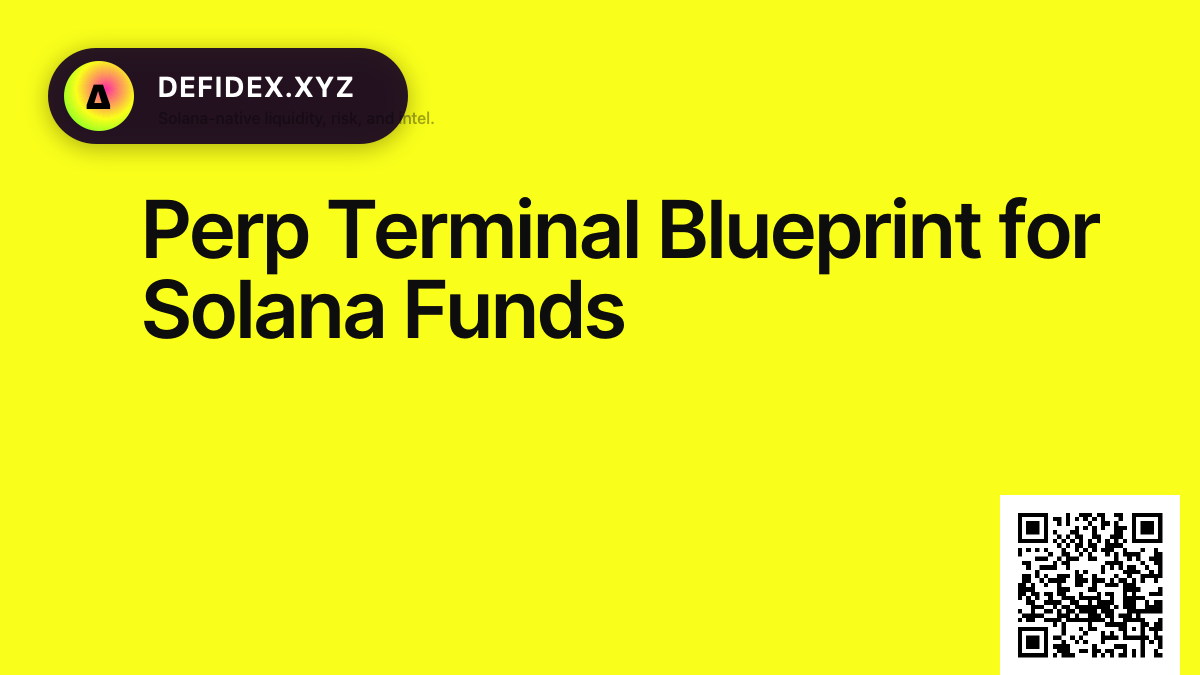Blog
Perp Terminal Blueprint for Solana Funds

Perpetual traders crave CEX-grade tooling without the custodial baggage, and that tension is the entire reason this blueprint exists. A modern Solana desk needs portfolio managers to sign in with Fireblocks or other MPC flows, quants to poke at data via secure APIs, and traders to click straight from Phantom without giving up approvals to an intermediary exchange. Our reference architecture therefore begins with identity: multi-role policies assign entitlements to wallets, HSM-backed keys, and even human operators so you can express exactly who can quote, hedge, and withdraw. The onboarding wizard writes those rules into on-chain registries while mirroring them to your compliance archive.
Once session control is live you need real liquidity, and that means orchestrating multiple venues as if they were a single surface. DeFiDex pipes quotes from Jupiter, Phoenix, OpenBook reboot pools, and our internal inventory vault into one normalized stream with microsecond timestamps. Routing policies decide which venue clears the order based on available depth, maker rebates, risk concentration, or even carbon-aware preferences if your LPs demand it. Because everything sits on Solana, the hop from quote to confirmation remains sub-second even when we enforce three or four checks along the way.
Execution quality depends on modeling slippage and mark impact before the packet leaves your terminal. The blueprint therefore recommends building a pre-trade analytics module that looks eerily similar to the preflight screens you see on large CeFi derivatives exchanges. We inspect leverage, margin ratio, VaR deltas, historical volatility bands, and liquidation proximity for both the initiating wallet and the aggregated market. If any metric breaches the guardrails, the trade is either resized, partially hedged via another venue, or routed to a human-in-the-loop queue with Slack, Telegram, and PagerDuty hooks.
Latency discipline is still non-negotiable. We encourage funds to deploy regional RPC nodes or to rent bare metal close to their custodians so nothing is left to best-effort connectivity. The terminal blueprint reserves dedicated compute for transaction building, signature aggregation, and bundle simulations that test multiple pathfinding outcomes before finalizing the packet. By the time an order hits the network the desk already knows the likely fill price, maker rebates, and worst-case reversion, enabling you to keep internal PnL dashboards aligned with the blockchain reality.
Streaming risk is the other pillar. Our reference deployment includes continuous monitoring of perps greeks, index divergence, counterparty exposure, and cross-venue liquidation queues. Rather than waiting for a margin call, the system nudges traders through in-terminal banners and sends structured alerts to whichever workflow tool your desk prefers. Because every state change is stored as structured data, you can model hypothetical scenarios—what happens if SOL gaps 12% overnight, for example—without exporting data to another system.
The post-trade layer is where most funds either shine or stumble. We package every fill, cancel, funding payment, and liquidation into signed JSON blobs that can feed your OMS, fund administrator, and regulatory archive. Need a FATF Travel Rule payload? Flip the switch and the required fields are included automatically. Need to prove best execution to an LP? Pull the archived quote ladder and you can show that DeFiDex beat competing venues by specific basis points.
An overlooked aspect of moving from CEX rails to on-chain rails is the human factor. Operators need dashboards that feel familiar. Our blueprint recreates the canonical terminal layout—order book, depth chart, blotter, and risk widgets—but also adds native Solana context like priority fees, blockhash freshness, and realtime validator health. Training your team becomes trivial because they are never staring at a science project; they are inside a neon-fast derivative workstation with the muscle memory of legacy platforms.
Finally, we emphasize agility. Strategy teams can fork the UI, add programmatic controls for options or cross-collateralization, and ship those changes without waiting on a centralized counterparty. Release trains hook into your existing CI/CD so compliance can review diffs, sign off on migrations, and automatically regenerate documentation. Within two weeks most funds replacing brittle CEX APIs discover that they not only gained custody control but also unlocked differentiated features their competitors cannot ship.
When you synthesize all of these ingredients—identity, liquidity orchestration, pre-trade guardrails, lightning settlement, and auditable post-trade data—you end up with a Solana-native perpetual terminal that behaves like a mission-critical product from day one. That is the standard LPs expect, and it is exactly what this blueprint delivers.
